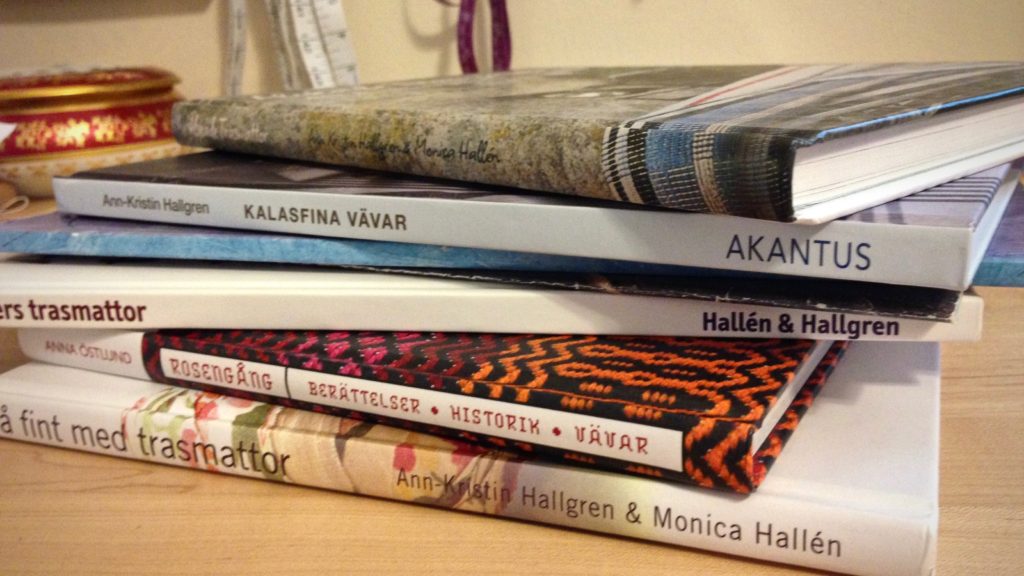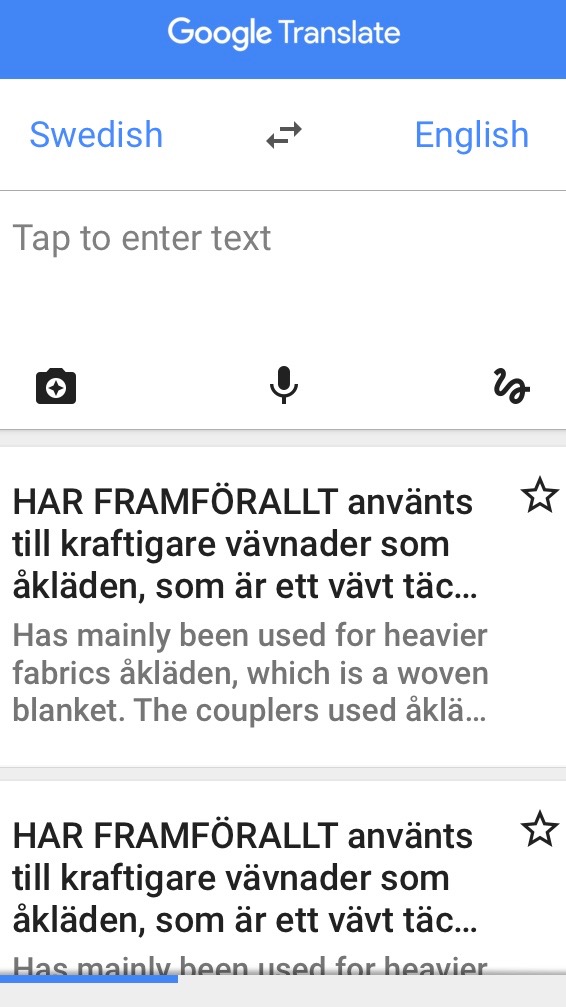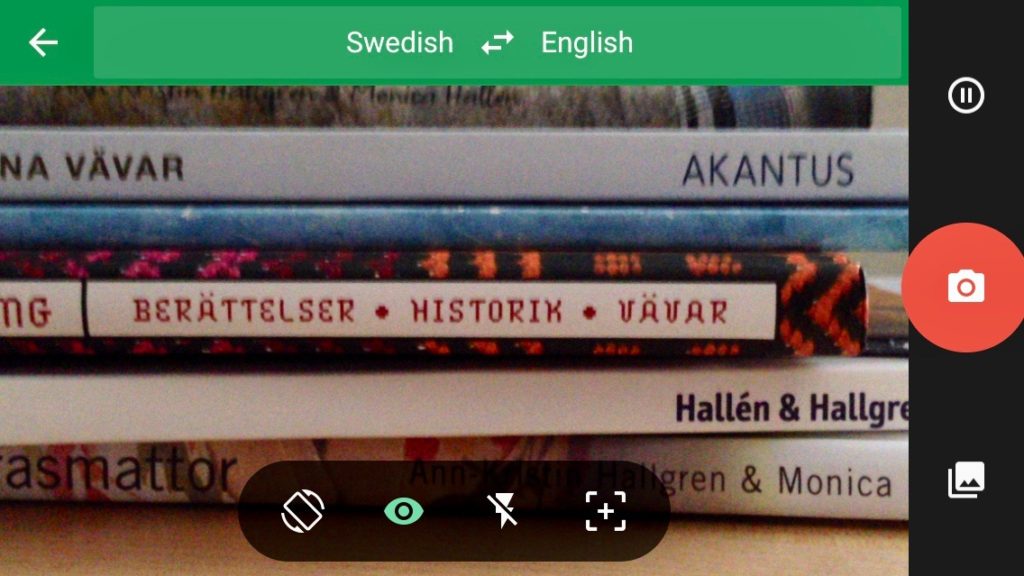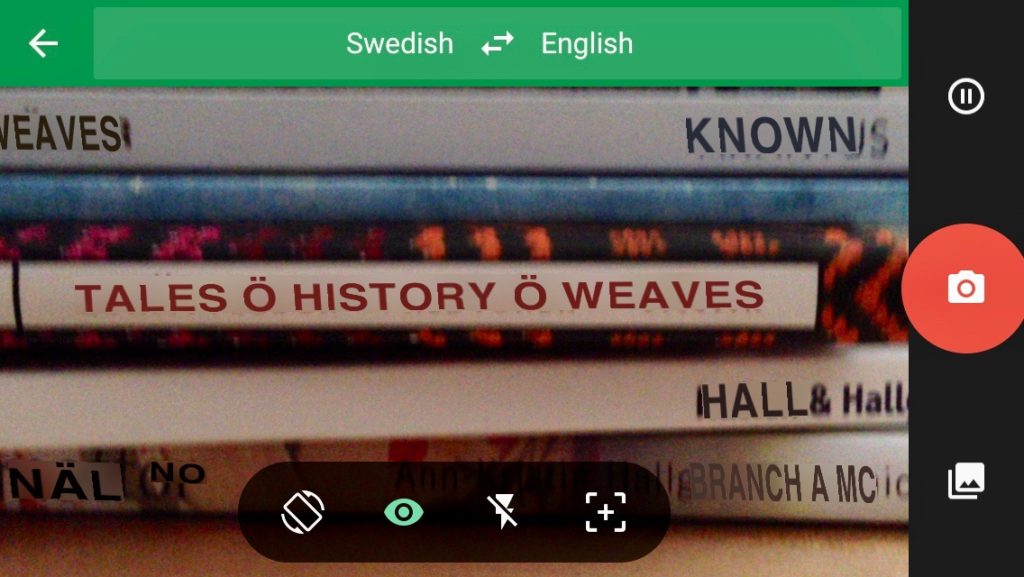Through my exploration of Swedish weaving techniques, I have acquired several Swedish weaving books. Fortunately, I also found a Swedish-English weaving glossary with pages and pages of translated words. Looking up a word at a time, I slowly made my way through small portions of the books. And then I discovered Google Translate, an app for my iPhone!

Google Translate allows me to type Swedish words or phrases, or try to speak them, and it gives me an English translation in return. The app also allows me to hold the phone’s camera over printed words, and the translation shows on the phone’s screen.

I’m the first to admit that Google is unfamiliar with standard weaving terms, and the results can be humorous. “Varp” might be translated as “Puppy,” “Inslag” as “Element,” and “Sked” as “Spoon.” But “Warp,” “Weft,” and “Reed” are easy to understand because of their placement in the instructions. Shouldn’t Google brush up on vocabulary for handweavers? Overall, the Google Translate app is a useful tool for understanding the basics of a Swedish draft and instructions.


Now, all I need are a few more Swedish weaving books!
May you overcome a language barrier.
Vävglädje (Happy Weaving),
Karen

Well, even though I speak Swedish, today I learned the word åkläde, which is a blanket made from two pieces sewn together in layers. 🙂
That’s a very clever app!
Hi Pia, It’s always fun to learn new words!
Karen
Back in the dark ages I wanted to go to a college that taught Swedish (assuming that a language was required). My grandparents were Swedish and spoke it in the home. Unfortunately the only college that did and also offered my major was in California. I lived in CT and there was no way my parents were going to let me go that far.
Wonder if that school also taught weaving? 🙂
Google Translate is awesome. I didn’t know there was an app!
Hi Betsy, It’s not hard to imagine that you were interested in learning Swedish at that age, since you had grandparents who spoke Swedish.
I could have taken weaving classes at my university, but I was in the music world at the time, and hadn’t yet been exposed to the world of weaving. Oh, the what ifs…
Karen
Have you seen the book lists on some of the Scandinavian Weaving groups? Sara Von Treskow kindly put up an exhaustive list of the books in her personal library and a very nice Swedish weaver, whose name escapes me this early in the morning, did another very good one. They’re worth finding and make great shopping lists.
Oops, didn’t mean to be anonymous, sorry.
Hi Joanna, I’m not familiar with the Scandinavian weaving groups. I’d love to see those lists of books!
Karen
I don’t know about the app, but on the google translate website you can help by contributing better translations. A lot of it relies on context so if you (and other weavers here) update the weaving words in weaving contexts it will learn!
Hi Kat, I didn’t know that about Google Translate. I can’t find anything on the app that lets you contribute better translations, but that’s great that the website takes that kind of input. We could really get a good Swedish-English weaving glossary at our fingertips!
Karen
You have quite a fan club on Facebook! Several people have recommended your blog to me, as I recently purchased a Glimakra Ideal, but haven’t warped it yet because I find it so overwhelming. But I am eager to get started!
As for Swedish, there is a super neat language learning site called Duolingo that you can learn basic Swedish on, if you’d like to extend your understanding of your books. Google Translate is decent, but as you’ve found, it’s also limited.
I am learning a great deal from your blog, so thank you for your generosity to new weavers.
Hi Majorie, I wasn’t aware of a fan club. Haha. That’s cool. It gives me joy to hear that I am helping other people, especially new weavers!
I know it can feel overwhelming to warp the Ideal the first time, but if you have the steps to follow, you’ll do just fine. It’s pretty exciting once you get going.
I checked the Duolingo site. It looks great. Thanks for the tip!
Happy weaving,
Karen
Hello Karin! It is now March 2022, a few years after the last post here… I, too, have interest in learning Swedish, but mainly for weaving. I’ve learned how to weave in Sweden (I live in France), have many SV books, and my good friend/teacher is Swedish. I use Google Translate when I don’t want to be too much of a burden on her (lol), but you can imagine how that sounds on the other end… GT is not famous for technical term translations, but I’m grateful for having it, just the same.
For Swedish and French terms, I have various translations/sources (and I would be happy to dig them out and share them if anyone asks. Some of them are already mentioned in some Replies on this Page). If it is a technical term that GT translates to spoon or puppy or who knows what, I use those lists, and for the rest of the Swedish text, I use Google Translate. It takes time, but I’ve become quite patient since I’ve started learning to weave (who hasn’t???!). So, you and I are/have learned to decipher our Swedish books this way.
I do not concentrate so much on the French terms yet as I am not weaving with other French speakers, and I don’t want to overload my intake. But I have weaving books in French, and at times have had to converse with French-speaking weavers, so I do occasionally have to use French terminology.
I have 2 Swedish countermarch looms at home, and I get my parts and materials directly from Sweden, so I am getting used to Swedish weaving terminology.
So, if anyone wants to keep this thread going, I’m listening! Glad you brought up the subject, Karen.
i vävning litar vi på/In weaving we trust,
Deborah B.
Hi Deborah, What an interesting journey you have had in weaving! Thanks for your input. I am happy to welcome you here.
Karen